IAC News
IAC News No.137, March 2024
Japan Society of Civil Engineers International Activities Center March 5, 2024 IAC News No.137
The IAC News introduces significant and unique international projects, technologies, symposium, communication undertaken by JSCE IAC, International Section, ACECC, and Research & Development Section with over 30 committees, state-of-art- civil engineering technologies and projects, great and interesting achievements of civil engineer and researcher once a month.
This month’s issue offers you various messages and information. It can be a page-turner. At first, Dr. Makoto Kimura the JSCE IAC Senior Director discusses the role of JSCE and what the IAC can and should do to achieve that role. Then, JSCE Design Prize 2023, which the Sub-committee of Civil Engineering Design Prize took long time to select, long-awaited Revisions of Standard Specifications for Concrete Structure and their English version, JSCE 2022 Infrastructure Maintenance Project Awardees: Matadi Bridge, which was built by Japan and the Republic of the Congo as an ODA project, and the Tomei Expressway Yamato Tunnel widening project which is expected to reduce chronic traffic congestion.
We are happy to receive your interests, requests and feedbacks anytime. Thank you
Role of JSCE in Overseas Projects
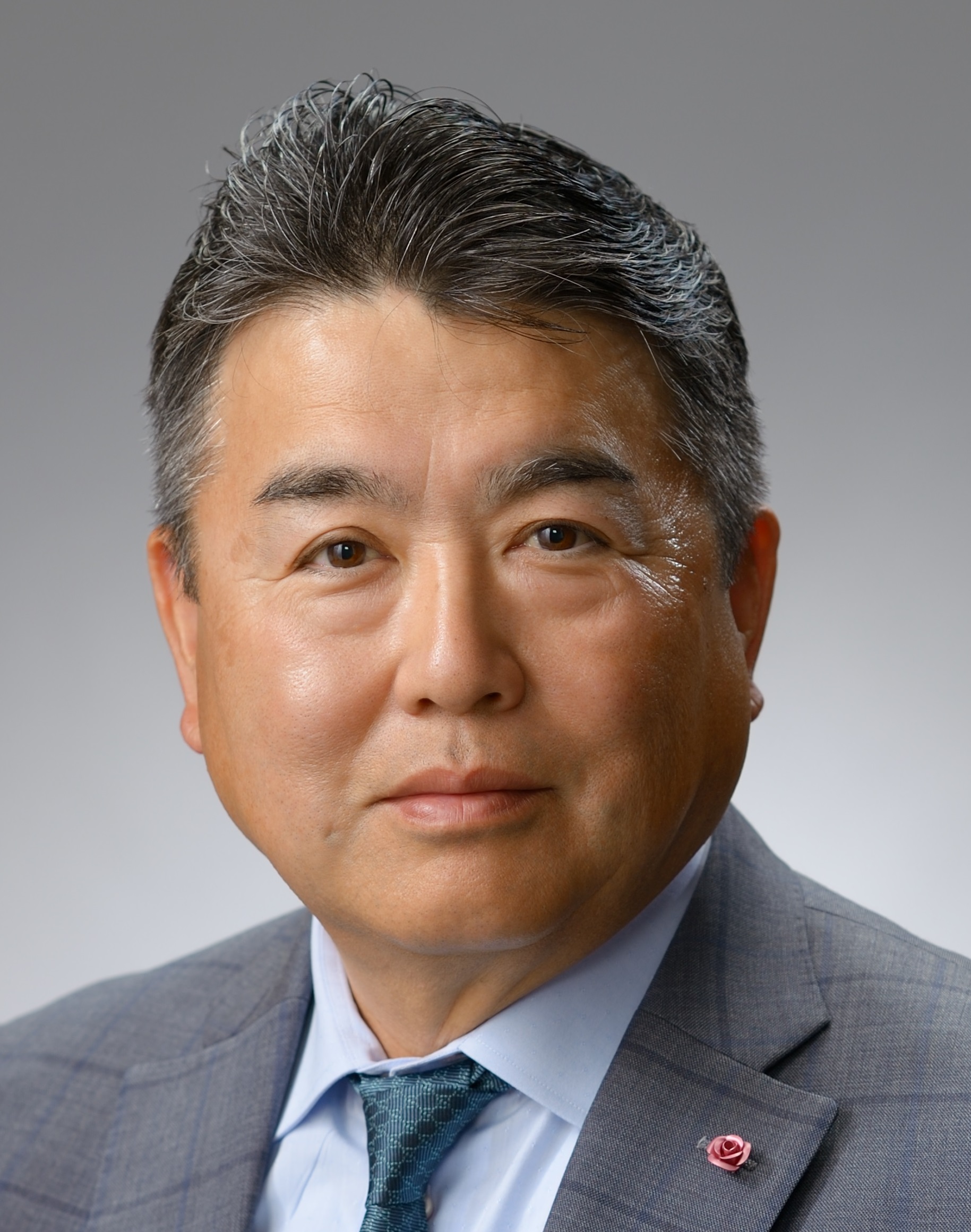 Makoto Kimura
Makoto Kimura
(Senior Director, IAC)
JSCE agreed on a partnership with the Japan International Cooperation Agency (JICA) five years ago. Thirty years ago I was involved in a JICA project to create a university in Kenya, Africa, and learned what international cooperation is all about by doing the dirty work on the front line. Ever since I have visited the sites of many JICA construction projects all over the world funded by either grant aid or repayable financial assistance. I would give advice at the site before the construction work began and personally suggest solutions to problems that occurred on the front line.
JSCE is an organization made up of members with civil engineering expertise from industry, government, and academia. With regards to JICA’s civil engineering projects funded by grant aid or repayable financial assistance, JSCE’s opinions and comments as a third party would surely be sought after in each stage of a project such as before, during, and after the design and before, during, and after the construction. For me at least, at construction sites where I was asked for advice after a problem occurred, there were many instances in which a whole host of measures could have been proposed if the project team had consulted me earlier at the design stage or the stage before the construction.
Perhaps young members, who have little experience on international construction sites, should join forces with the more senior members and learn from them. ODA projects are also an opportunity for the more senior members to flourish. Even if it is argued that there are consultancy firms, construction companies, and various bodies and associations out there to do this kind of work, carrying out designs and constructions of no national interest in foreign countries unknown to ordinary people is a waste of taxpayers’ money and will be an embarrassment for Japan.
If the designers and construction managers are the same individuals in international projects, it is difficult to correct one’s design if it is wrong when managing the construction. The fundamental position of consultancy firms, which get paid even if the work schedule is longer than expected, and construction companies, which do not get paid if they do not observe the construction timeframe, is completely different when a problem occurs. If a problem were to occur, however, perhaps JSCE could act as a kind of referee. There is nothing more tragic and futile than two fellow Japanese members butting heads.
I would like the International Activities Center to take another look at the role of JSCE at the sites of international construction projects and think about how Japanese engineers can showcase their skills overseas. For this, we will surely need the exuberance and innovative thinking of young engineers as well as the capabilities of more senior engineers. You can expect big things from the International Activities Center!
【Reported by Makoto Kimura, Senior Director of IAC, JSCE】
JSCE Design Prize 2023
In November 2023, the results of the nominees for the JSCE Design Prize 2023 were announced. Of the 20 nominees, three were awarded the Grand Prize, six were awarded the Outstanding Performance Award, and three were awarded the Honorable Mention Award. I served as Chairperson on the judging panel, and I would like to take this opportunity to express my heartfelt appreciation to everyone who entered, including those projects that narrowly missed out on being nominated, as well as all the organizations that helped make the awards a success. The screening of the awards saw all the projects that had made it through the initial paper screening undergo a second in-person screening by multiple panel judges. The in-person screening is held every year from summer to autumn, with the summer of 2023 reaching a record high in terms of average temperature. I salute all the judges who visited to observe the fruits of the projects in person and all the event organizers for working under these sweltering conditions.
As Chairperson of the judging panel, each year I feel that the range of entries is becoming more and more diverse. While the nominees for civil engineering design are what is known as “infrastructure,” which is mainly bridges, roads, rivers, parks, etc., the renovation of areas as a whole, including public facilities such as community centers, halls, and libraries, were also up for an award. That is, because of the projects being different scales and types and complex examples of craftmanship, recently, there have become more and more cases of judging excellent achievements in terms of design and planning, maintenance, and the running of the projects. That is why frank discussions between the judges take place every year about what defines the category of civil engineering design and what items should be assessed and the importance of each assessment item, such as technology and craftsmanship, timeframe, and value to the general public (the second screening for fiscal 2023 lasted a whole nine hours or so when combining the duration of the observation report and the final selection).
I will now introduce the three projects that won the Grand Prize for fiscal 2023. The first was the Kawamachi Restoration Project of Kyukitakamigawa River in Areas of Ishinomaki City. This project was implemented in Ishinomaki City, Miyagi Prefecture, which suffered enormous damage from the tsunami that struck following the Great East Japan Earthquake. The project was praised for both improving the flood control safety of Kitakamigawa River, which had previously been without levees, and developing the city by utilizing the waterfront. The second was Hanabata Hiroba Square in Kumamoto City. This project implemented a design to join together public areas by converting approximately 230 meters of roadway following Kumamoto Castle into a space for pedestrians. Under the concept of establishing a large town square adjacent to Kumamoto Castle, a new landmark was created that symbolizes the city’s recovery from the earthquake that occurred in Kumamoto in 2016. The third was the Saiki Shiroyama Sakura Hall and Otemae District Project in Saiki City, Oita Prefecture. Renovation work was undertaken to blend the appearance of the district aesthetically with the surrounding townscape and spark connections and a sense of life with existing shopping streets in the district and surrounding areas to rejuvenate the Otemae District, which was once the most lively area in Saiki City, as well as introduce programs for the active engagement and diverse participation of local citizens. For details on the other projects awarded the JSCE Design Prize, be sure to visit the website (https://design-prize.sakura.ne.jp). We look forward to receiving a lot of entries for the next set of awards in 2024 as well!
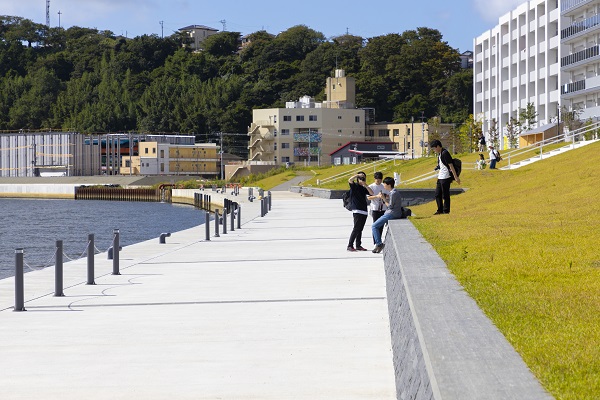
Kawamachi Restoration Project of Kyukitakamigawa River in Areas of Ishinomaki City
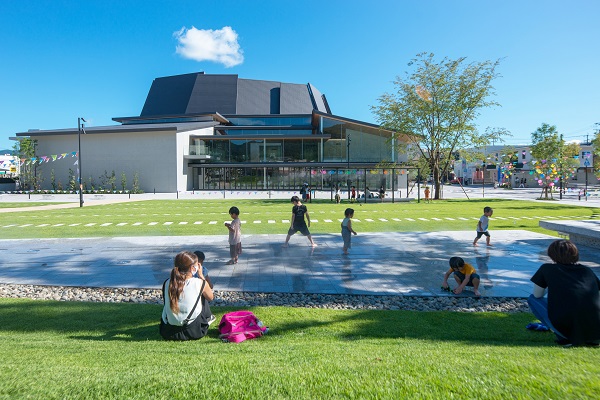
Hanabata Hiroba Square (Kumamoto Machinaka Hiroba Square / Karashima Park / Hanabata Park)
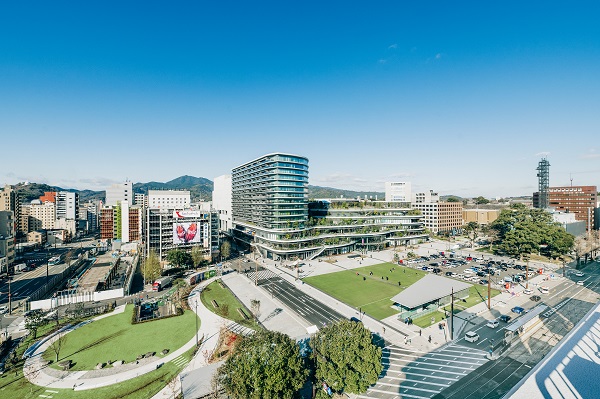
Saiki Shiroyamasakura Hall, Otemae district
【Reported by Hisashi Shibata, Chairperson, Subcommittee of Civil Engineering Design Prize,
Landscape & Design Committee】
Overview of Revisions to Standard Specifications for Concrete Structures and Their English Translation
1. Overview of Revisions
The current JSCE Standard Specifications for Concrete Structures are made up of the following sections: Basic Principles, Design, Materials and Construction, Maintenance, Dam Concrete, and Test Methods and Specifications. As part of the specifications established in 2022, the Basic Principles, Design, and, Maintenance sections were revised, with the Materials and Construction and Dam Concrete sections revised as part of the version of the specifications established in 2023. For the Basic Principles and Dam Concrete sections, it was the first revision in 10 years since the 2012 version of the specifications, and for the other sections, it was the first revision in approximately five years.
The overall features of the latest set of revisions are as follows:
(1) Bringing Renovation to the Forefront
The requirements and performance of social infrastructure change depending on shifts in society and the economic climate. The demand for not only new installations but also renovating existing structures and integrating new and old structures together has increased, and as such, there is a strong call for the specifications to also reflect this. Thus, there was a need for performance assessments of existing structures and to tackle problems arising along with integrating new and old structures, and as a result, efforts to link the Basic Principles, Design, and Maintenance sections have advanced.
(2) More thorough Explanations
The Standard Specifications for Concrete Structures are composed of a main text and explanations. In the explanations up to now, numerous expressions were considered similar to the provisions in the main text, and this was one of the reasons why the Standard Specifications for Concrete Structures were criticized for being difficult to understand. This issue was looked at closely in the latest set of revisions, with the explanations made more distinct from the main text to provide proper explanations.
(3) Publishing of a Digital Copy as well as a Physical Copy (Japanease Version)
Many people have asked about getting a digital copy of the Standard Specifications for Concrete Structures due to the digital copy being easier to carry around and search compared to the bulky physical version. The JSCE Publishing Committee began sales of a digital version of the previous 2017 edition in 2022. The latest edition is now available as both a physical and digital copy from the outset.
2. About the English Translation
Ever since the first edition of the Standard Specifications for Concrete Structures was published in 1931, it has been revised almost every five years to match the advancement of technology. An English version of the specifications was also produced for the 1986, 2002, and 2007 editions. While an English version was no longer produced from the 2007 edition onward, the need to share this information with the wider global community was reaffirmed and an English version of the latest edition was produced after about two years of hard work. Currently, the original Japanese version of the Standard Specifications for Concrete Structures is divided into different volumes such as the Basic Principles, Design, Materials and Construction, and Maintenance sections, with each section made up of a “Main Text” section that forms the backbone of the performance-based specifications, as well as a “Standards” section that indicates the standard technical information. The latest English version places an emphasis on effectively communicating the structure and overview of the specifications from start to finish, with a full translation of the “Main Text” of each section and an abridged translation of the “Standards” section compiled into a compact book. For many people to get easy access and read the specifications, a digital version was made available for free online. However, due to reasons relating to the schedule for translating the original Japanese version into English, the content was based on the previous 2017 edition of the specifications. I hope the English version of the specifications proves useful in sharing technical information about concrete structures in Japan with the rest of the world, as well as in training, research, and practical work.
・JSCE Concrete Committee Website: https://www.jsce.or.jp/committee/concrete/e/index.html
【Reported by Concrete Committee】
Matadi Bridge: a Suspension Bridge Built by Japan and Democratic Republic of the Congo and Maintained by the Hashimori Bridge Maintenance Task Force
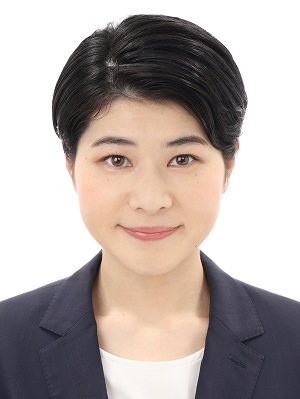
Sumire
Watanabe
(JICA)
My first business trip when joining the Japan International Cooperation Agency (JICA) was to Democratic Republic of the Congo. After traveling eight hours or so by car on National Road 1, a bumpy road stretching 350 km from the capital of Kinshasa, we arrived at the city of Matadi. The Matadi Bridge lies at the point where the colossal Congo River, which is the second-longest river in Africa, intersects with the country’s main logistics artery, National Road 1. The Matadi Bridge is a 722-meter-long suspension bridge that was built 41 years ago with Japanese ODA when the Democratic Republic of the Congo was still called the Republic of Zaire.
While the Matadi Bridge was 39 years old when I visited the site in 2022, it had not once undergone any large-scale repairs. Nonetheless, the bridge had been kept well looked after, with the paint coating of the bridge in good shape, everything up to the drainage channels kept clean, and the hanger ropes nice and tense. With trucks and people constantly going over the bridge, it was obvious that the bridge is an important structure in supporting the country’s logistics and the lives of its people.
The history of Japan assisting work related to this bridge dates back a long way, with the Japanese engineers preaching the importance of maintenance and management to the Congolese engineers from the outset of the construction. The trust between the Japanese and Congolese engineers was strong, and despite assistance from Japan ceasing during the civil war in Congo during the 1990s, the previous generation of the Hashimori Task Force contacted the consultants and construction operators in Japan and were able to maintain the Matadi Bridge themselves while receiving guidance remotely. Assistance from Japan later resumed in 2012, and in the same year, the Project to Improve Maintenance and Management Capabilities was launched to help improve the proficiency of bridge inspections, maintenance, and management, as well as to train young engineers. In 2014, under the Matadi Bridge Maintenance Plan, a cable ventilation and drying system was installed as a measure to prevent the main cables from corroding. The ability to maintain and manage the Matadi Bridge was further improved by these projects, and it was awarded the JSCE 2022 Infrastructure Maintenance Project Award. While staying in the Republic of Congo, I met people who were involved in the construction of the bridge from day one. What made a lasting impression on me was how these people, despite growing old, treated the Matadi Bridge with such affection as if it were one of their own children. From observing the interactions between the Congolese engineers, I really felt that the spirit of the Hashimori Task Force has been properly inherited by the young engineers who are currently at the frontline, maintaining and managing the bridge.
The series of projects related to the Matadi Bridge is an example of properly taking every step to transfer maintenance and management skills to ensure the structure is kept safe and in sound condition for many years to come rather than just working together to simply build something and move on to the next project. While JICA has engaged in a large number of initiatives and projects to maintain and manage roads, such as the Road Asset Management Cluster, I hope that we will actively continue to work to develop local engineers and ensure the infrastructure remains sound for the long term.
Lastly, while I was in Democratic Republic of the Congo I was able to walk across one of the main cables and climb to the top of one of the main towers of the Matadi Bridge. Once I started climbing I could not look down until I reached the main tower because it was so scary. The helmet that I was given had the logo of a Japanese company on it, perhaps because it was left there by an engineer who had stayed in the country long ago. This also gave me a sense of the long history of assistance Japan has played in building and maintaining this bridge.
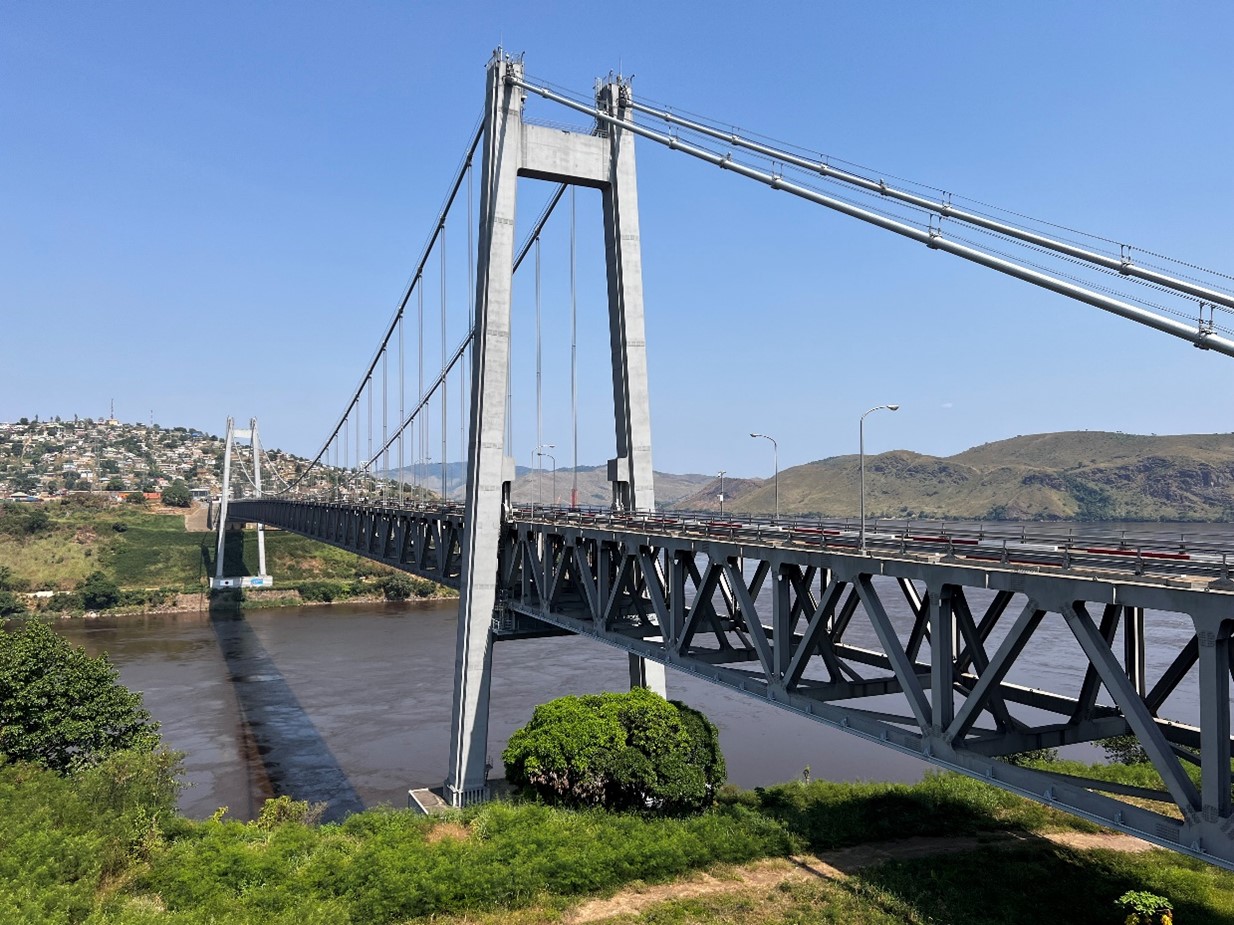
Wide View of Matadi Bridge
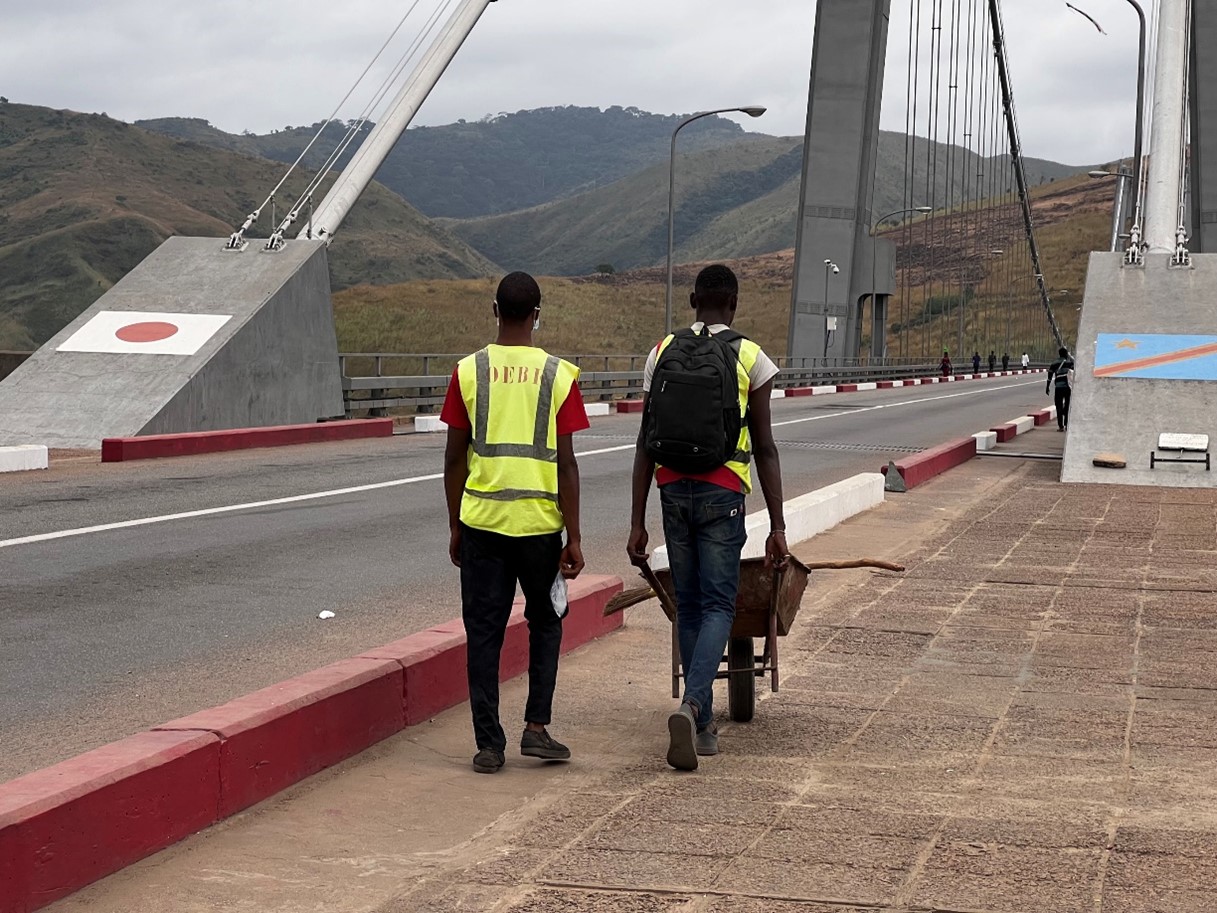
Staff Undertaking Cleaning Work of Matadi Bridge
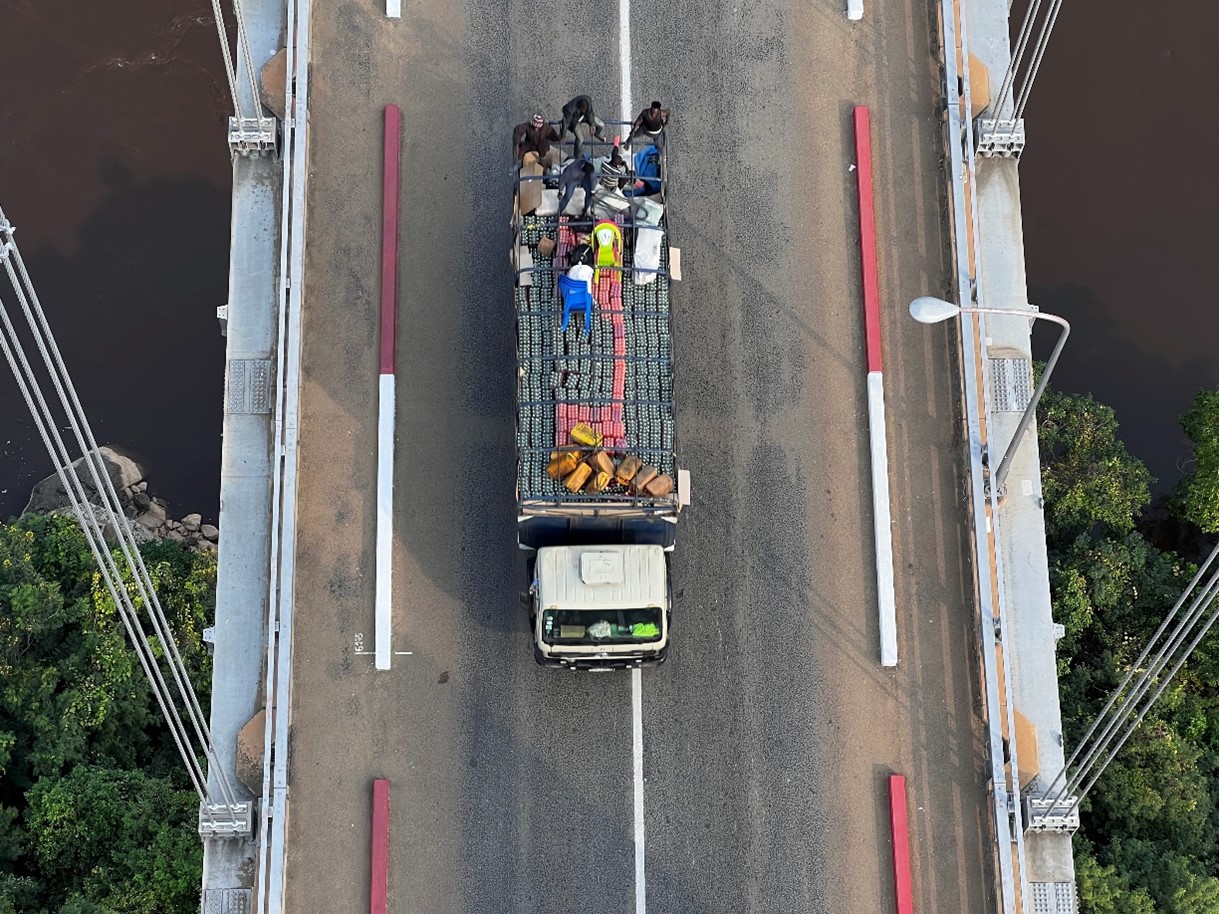
Truck Passing Over Matadi Bridge
【Reported by Sumire Watanabe, Japan International Cooperation Agency】
Yamato Tunnel Widening Project for the Tomei Expressway
– Relieving the Worst Congestion in Japan -
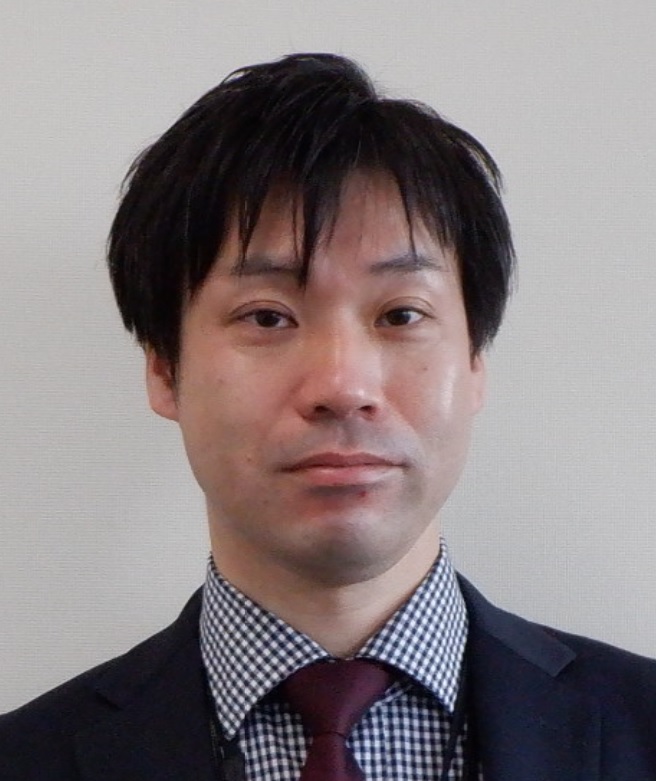 Takeshi Yamaguchi
Takeshi Yamaguchi
(NEXCO CENTRAL)
1. Project overview
Over 130,000 vehicles travel from the Yokohama-machida Interchange to the Ebina Junction on the Tomei Expressway every day. This volume of traffic, as much as anywhere in Japan, results in chronic and extremely strenuous levels of congestion due to the concentration of traffic. The area near the Yamato Tunnel (Photo 1) in particular sees a lot of congestion caused by vehicles slowing down at the sagging section where the tunnel slopes downward before transitioning to an uphill slope, as well as at the entrance of the tunnel. That is why the addition of a lane near the tunnel with three lanes on each side was planned as part of the measures against congestion, and consequently, it was determined that the width of the Yamato Tunnel would have to be made wider to make this possible (Figure 1).
2. Design and installation that made the complex widening construction possible
Because the area of the widening construction work was a major traffic route, it was difficult to put in place long-term traffic restrictions during the construction work. Consequently, the work to constantly ensure three lanes were open on either side while at the same time widening this wide-profile tunnel was extremely difficult. The efforts taken in the design and construction stages to resolve this issue are shown below.
(1)Creative Efforts in Design Stage
To minimize the traffic lane restrictions during the construction period, it was necessary to reduce the reinforcement of existing parts as much as possible in the widening design.
In terms of the design, in addition to making the joint between the widened side walls and the top slabs more rigid, the soil springs were adjusted by improving the ground directly below the widened parts, and measures were taken against the ground sinking. Furthermore, how the tunnel would be widened was examined before choosing an approach in which the stress on the existing parts would be reduced after widening the tunnel (Figure 2). Efforts were also taken to reduce the top load by removing the existing soil cover of the tunnel. As a result, a design to widen the tunnel was implemented that would minimize the reinforcement of existing parts.
(2) Creative Efforts in Construction Stage
In planning the construction, a method was proposed in which the construction work could be carried out in a narrow work space during fixed traffic restrictions by installing a temporary guardrail (Figure 3). The construction method was to support the top slabs with temporary supports in order to remove the existing side walls. In the work on the main expressway road, work to transport, install, and remove the materials, etc. had to be done in a narrow 2.15-meter work space, especially for installing the temporary supports and removing the side walls.
The temporary supports were installed to and later removed from their predetermined positions efficiently by lowering pre-cast temporary supports from the top of the tunnel entrance using a crane and then hauling them into the work area inside the tunnel using a winch along transport rails laid on the work platform, rather than transporting and assembling the materials from the main roadway. In the plan to bring the temporary supports into the tunnel, prior examinations were made using a 3D model to check the work would be safe and assured (Figure 4, Photo 2).
Removal of the side walls was done by cutting the walls into blocks rather than smashing the concrete, and, despite the tight work space, the blocks were efficiently carried out of the tunnel with a highly mobile forklift (Photo 3).
3. Opening the Additional Lane
The construction work to widen the Yamato Tunnel was completed without any problems by bringing to fruition the plan and design to minimize the existing reinforcements and achieve the widening work in a tight space while ensuring the three lanes remained open for traffic (Photo 4). In July 2021, the opening of an additional lane in specific areas helped significantly reduce congestion near the Yamato Tunnel.
4. Infrastructure Maintenance Project Award Winner
The Yamato Tunnel Widening Project for the Tomei Expressway won the JSCE 2022 Infrastructure Maintenance Project Award. To close, I would like to take this opportunity to offer my sincerest gratitude to all the experts who helped in the design and construction of the project, as well as everyone involved in the surveys, design, and construction work.
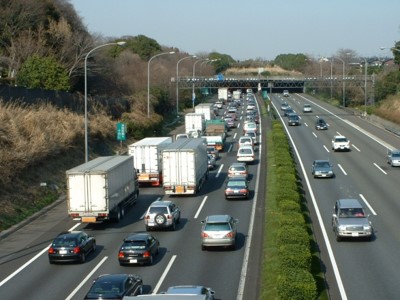
Photo 1 Congestion Near the Yamato Tunnel
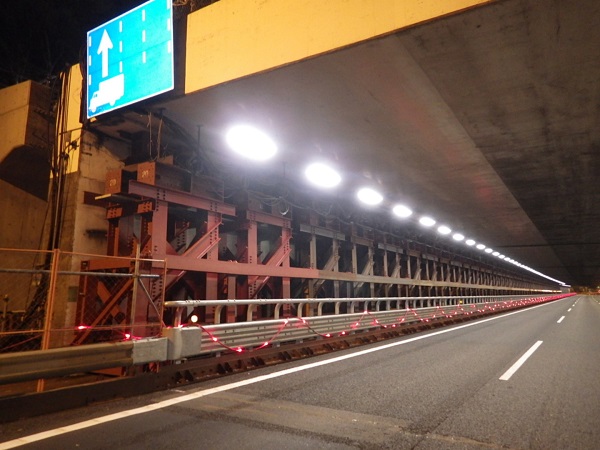
Photo 2 Installation of Temporary Supports
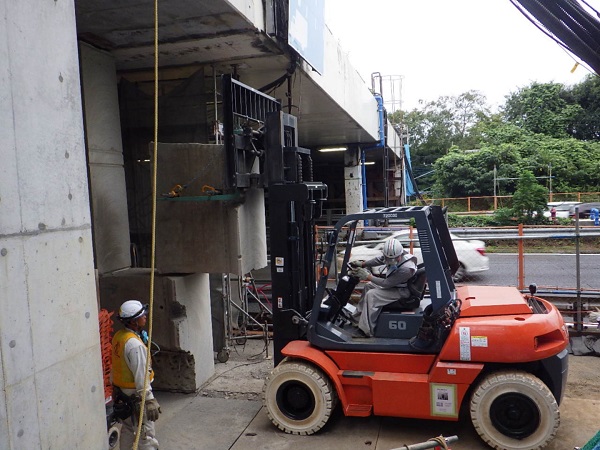
Photo 3 Transportation of Concrete Cut into Small Blocks
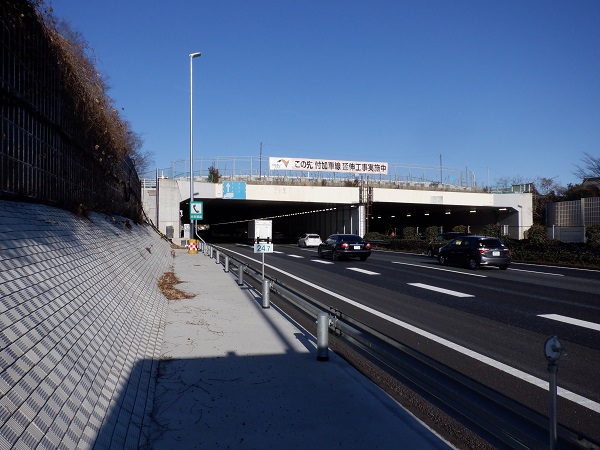
Photo 4 After Widening of Yamato Tunnel
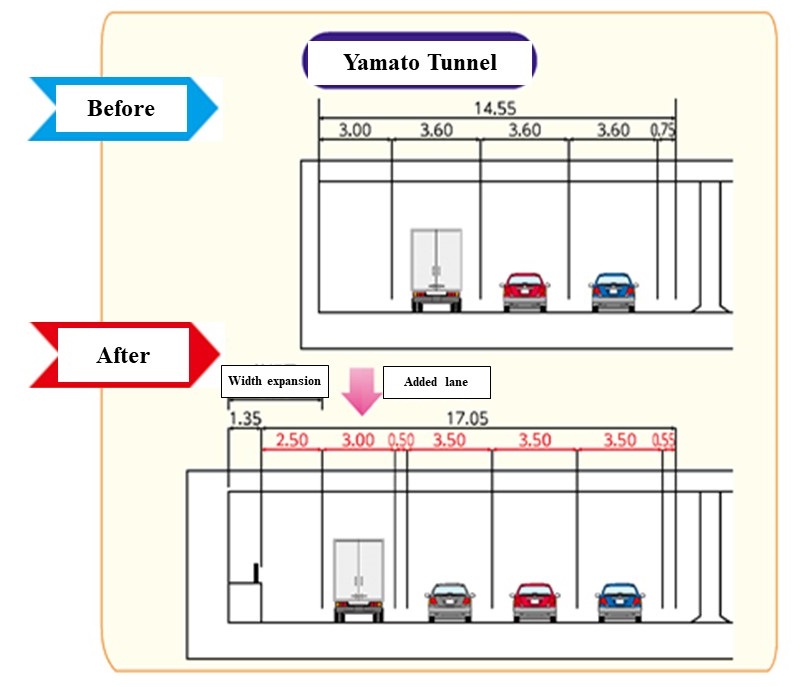
Figure 1 Standard Cross-Section Diagram Before
Figure 2 Creative Efforts in Design Stage
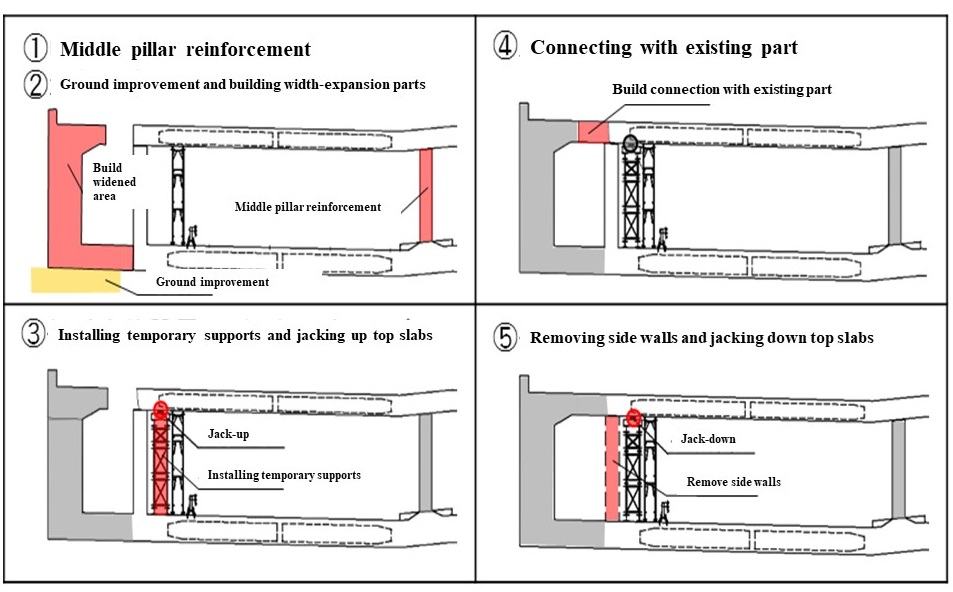
Figure 3 Steps for Widening Worke
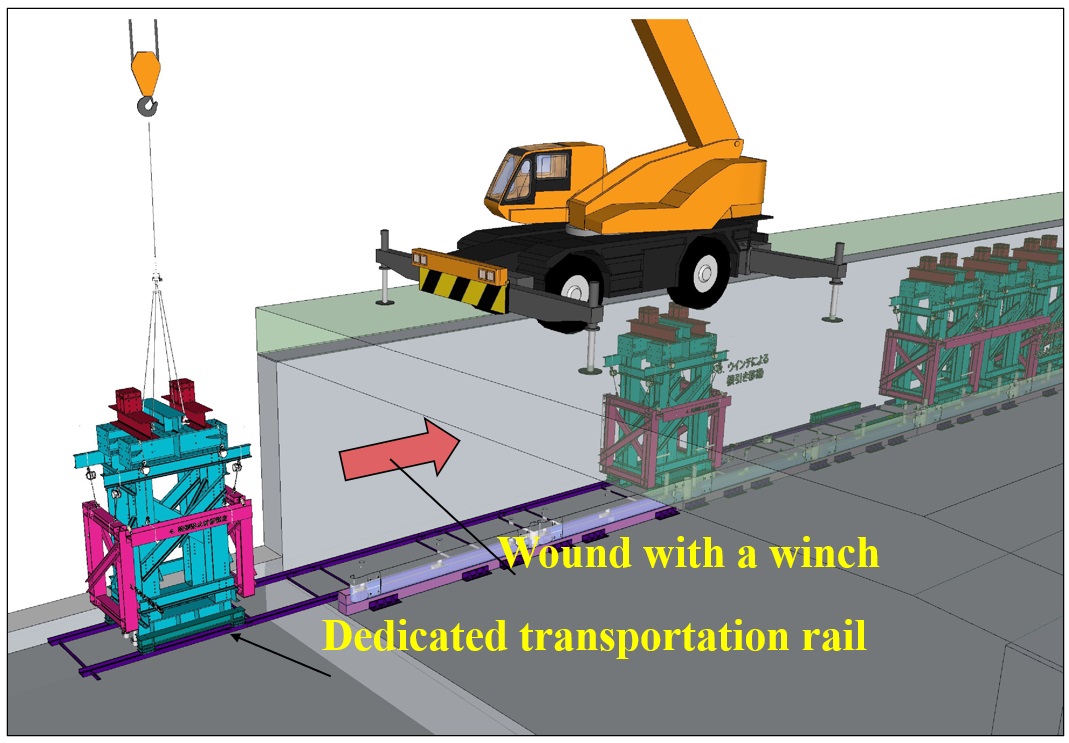
Figure 4 3D Model Simulation
【Reported by Takeshi Yamaguchi, Central Nippon Expressway Company Limited】
The 2nd Laos-Japan Joint Seminar “Road Asset Management”
On October 31, 2023, the 2nd Laos-Japan Joint Seminar "Road Asset Management" was held in Vientiane, the capital of Laos, with the cooperation of the Japan Society of Civil Engineers (JSCE), Japan International Cooperation Agency (JICA), the Ministry of Public Works and Transport in Laos, the National University of Laos, and the Association of Lao Architect and Civil Engineers.
The seminar aimed to share knowledge on road asset management between engineers and researchers from Japan and Laos, contributing to the further development of civil engineering. It was particularly expected that the sharing of Japan's long-accumulated experience, technology, and insights would contribute to solving road infrastructure challenges in Laos.
The event saw the participation of 114 onsite attendees with diverse backgrounds, including the Director General of the Department of Roads, Ministry of Public Works and Transport, and the Vice Dean of the Faculty of Engineering, National University of Laos, from both Japan and Laos. It served as a valuable opportunity for building and strengthening networks among participants.
During the seminar, five presentations from Lao engineers and researchers and seven from the Japanese side were delivered, focusing not only on technical content but also on the importance of human resource development and technology transfer. For example, from a technical perspective, Professor Kohei Nagai from Hokkaido University discussed the significance of road asset management and the utilization of data, while Associate Professor Takafumi Nishikawa from Nagasaki University presented on infrastructure monitoring using sensing devices. Additionally, Ms. Risa Kuroda from Shimizu Corporation introduced Japan's advanced technology, focusing on deck slab replacement works. From the perspective of human resource development and technology transfer, Associate Professor Koji Kinoshita from Gifu University talked about education for infrastructure maintenance in Japan, and Professor Henry Michael from Shibaura Institute of Technology presented research findings on effective technology transfer. Alongside the seminar, a poster session was also held, introducing ODA projects in Laos, as well as activities from Japanese and Laotian private companies and universities.
Engineers and researchers from Laos and Japan had lively discussions on the day, with many participants providing positive feedback, such as "many technologies and technical knowledge were shared through the seminar." According to the questionnaire survey among participants, 99% expressed high satisfaction, indicating a strong desire for further opportunities to share knowledge between Japan and Laos in the future.
In 2024, as Laos hosts many international exchanges as the chair country of ASEAN, I hope the civil engineering network between Japan and Laos will be further strengthened.
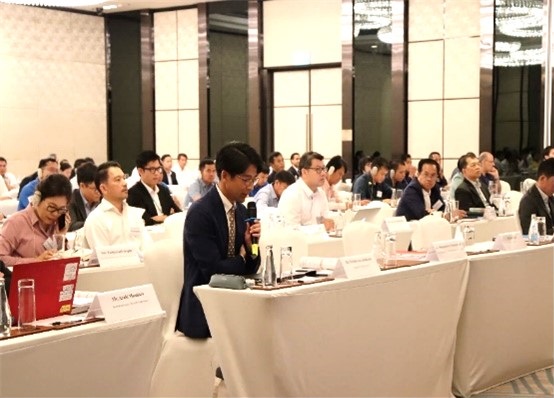
Assoc. Prof. Takafumi Nishikawa
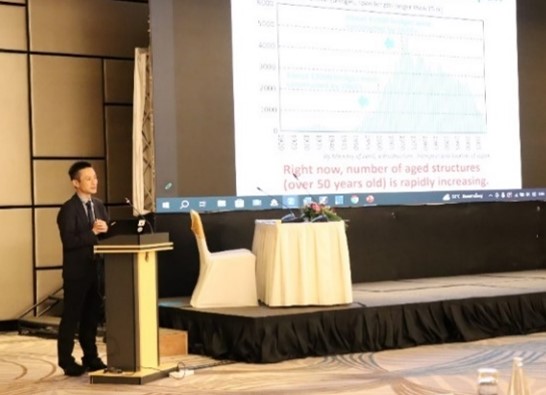
Prof. Kohei Nagai
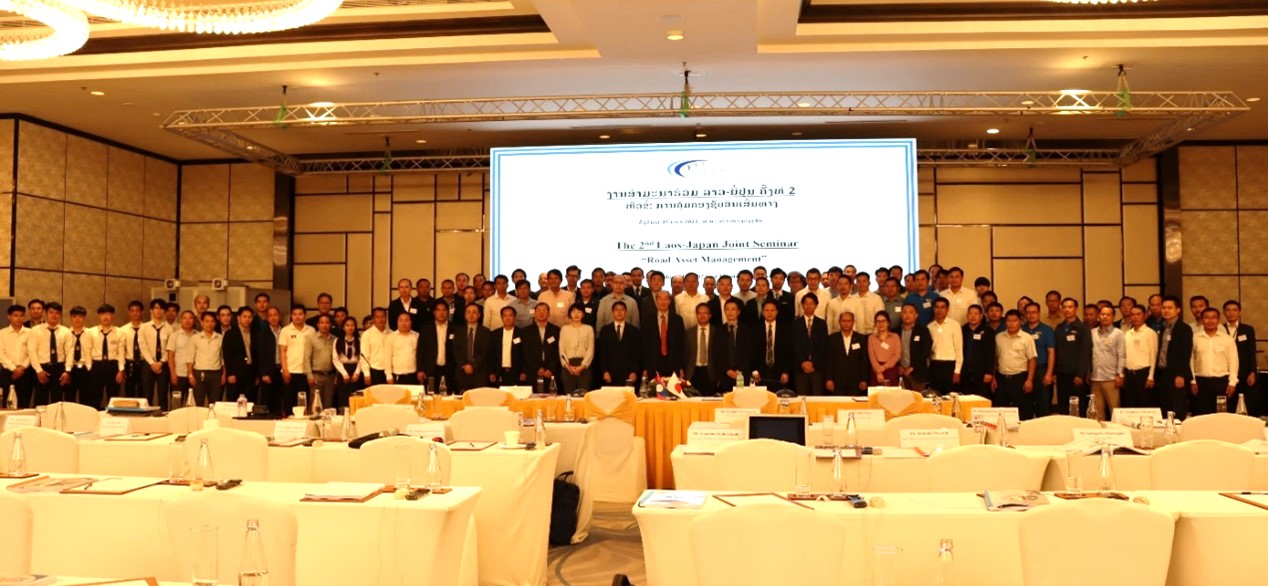
Seminar Participants
【Reported by Tatsuhito Kondo, Expert, the Project for Capacity Development on Bridge Maintenance and Management (Lao-PDR), JICA】
Updates
◆In response to 2024 Noto Peninsula Earthquake
https://www.jsce-int.org/node/873
◆The International Infrastructure Archives
– A Compilation of Japan’s Greatest Projects in Transfer of Civil Engineering Technology in Service –
http://www.jsce.or.jp/e/archive/
◆Infrastructure System Resilience: An Engineering Framework for Assessment, Management, and Governance
https://ascelibrary.org/doi/10.1061/9780784485088
◆6th JSCE Concrete Committee Webinar "Frontiers of Concrete Technology"
https://www.jsce-int.org/node/879
◆ IAC “News Pick Up!!” on the JSCE Japanese website
https://committees.jsce.or.jp/kokusai/iac_dayori_2024
◆【YouTube】 Civil Engineering, in Your own Words (Full ver.)
https://youtu.be/r1Dc37kABXM?feature=shared
◆2023 Civil Engineering Design Prize, JSCE
http://design-prize.sakura.ne.jp/
◆Summary of featured articles in JSCE Magazine Vol. 109, No.3, March 2024
http://www.jsce-int.org/pub/magazine
◆Journal of JSCE
https://www.jstage.jst.go.jp/browse/journalofjsce
◆Safe and Healthy Work in the Digital Age 2023-2025 Campaign
https://healthy-workplaces.osha.europa.eu/en/media-centre/events/launch-...
◆【YouTube】 Taiwan Public Infrastructure Archives: Public Water Supply Series
https://youtu.be/mMMvODevd_Q?feature=shared
◆CECAR10:http://www.cecar10.org/
Subscription
The IAC News is one of the communication tools to share information and ideas with the members. We would like to invite you, your friends and colleagues to join the communication and to subscribe the IAC News. Please register online: (http://www.jsce-int.org/node/150). We look forward to meeting you.
